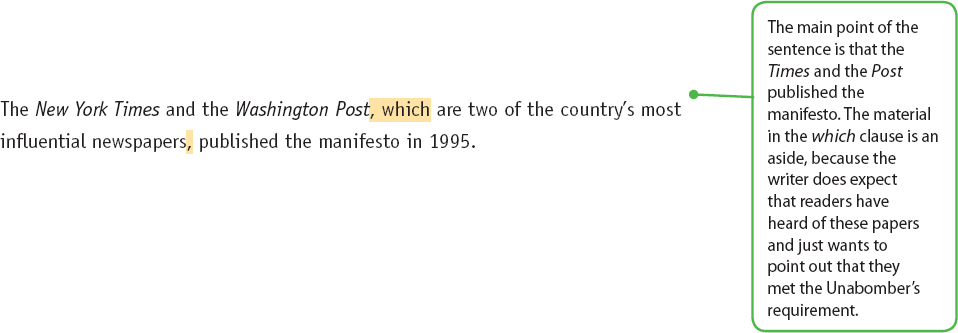Use Commas to Set Off Detours
Once you’ve gotten a sentence started, use commas — or, in special situations, dashes or parentheses — to set off elements that amount to detours from the main point, additions of background information, or asides. Use commas on both sides of such elements when they’re in the middle of a sentence. Use a single comma when the element comes at the end.


This principle doesn’t mean that the information or ideas you set off with commas is inessential to your overall point. But any sentence or main clause should have a point of its own. Material that detours from that point should be set off.
Many good writers also make a distinction between that, with no comma, and which, preceded by a comma, to give their readers one more clue about whether they consider an element essential to the point of the sentence. In the example below, the writer considers the subordinate clause beginning with “that explained” essential:

In the next example, the clause beginning with which is inessential:

Who, when, and where can be used either like that, without a comma, if they’re necessary to the main point of the sentence, or like which, with a comma, if they’re not.

Bear in mind that readers can find it frustrating to be sent on too many detours, even if these are correctly signaled with commas:
 A man who was the brother of Ted Kaczynski, who ultimately pleaded guilty to the bombings, and the brother’s wife, having recognized the writing style and ideas, tipped off FBI agents that the person they were looking for was Ted.
A man who was the brother of Ted Kaczynski, who ultimately pleaded guilty to the bombings, and the brother’s wife, having recognized the writing style and ideas, tipped off FBI agents that the person they were looking for was Ted.
One more decision about detour-related commas comes up with proper names. Do not use commas to set off proper names that are essential to the sentence and the point it is making:

Do set off names when the meaning would be clear and the sentence structure smooth without them:

Proper names that need to be set off generally refer to the only possible person or thing that the writer could be describing. In the example above, the brother has only one wife, Linda Kaczynski. In this example, Hawthorne cannot have written more than one first novel:
Nathaniel Hawthorne wrote his first novel, Fanshawe, in 1828.